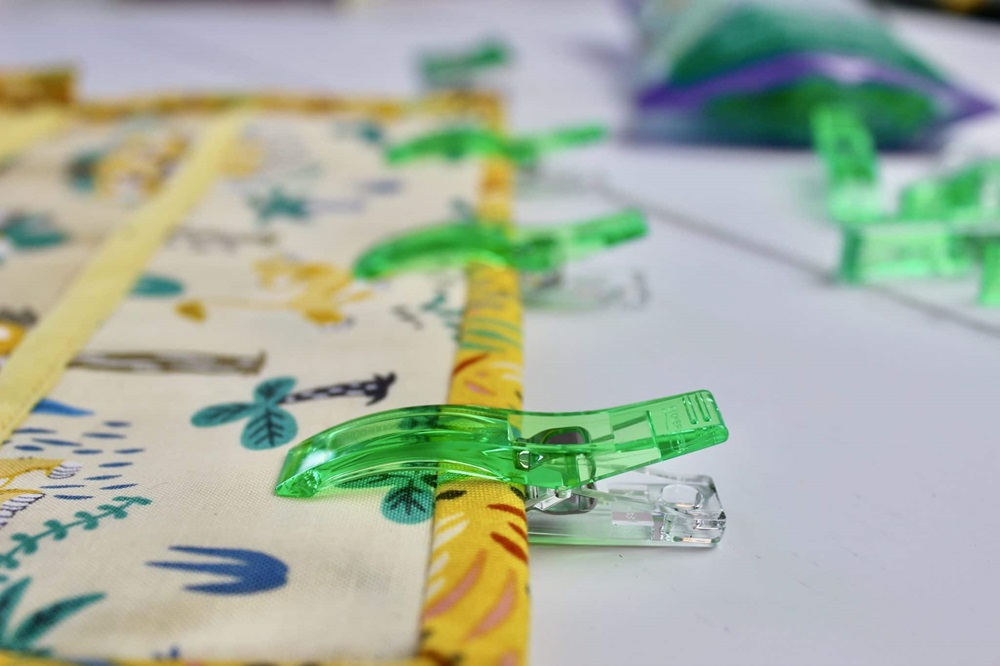Sewing clips are valuable tools that can replace traditional pins for various sewing and craft applications. Layers of cloth are kept firmly together during stitching by sewing clips. Clips are perfect for delicate materials since, unlike pins, they don’t leave holes in the fabric. Clips make stitching faster since they are easy to use and attach and remove. They work well with materials that are hard to pin, such as vinyl or leather, thick textiles, and several layers. The chance of inadvertently leaving clips in the cloth is decreased because they are often conspicuous and vividly coloured.
Sewing clips are indispensable in many artistic mediums, especially mixed media, textile arts, and crafts. Sewing clips hold delicate components in place without shifting, which is vital in artistic quilting and appliqué, where accuracy is essential. Clips keep fabric pieces precisely aligned during sewing, which is helpful for applications that call for pattern alignment. Sewing clips avoid puncturing delicate fabrics like silk or lace, preserving their integrity and appearance. When pins might flex or not be strong enough to hold together thick or several layers of cloth, like in upholstery or bag construction, they come in handy.
Because clips are easily adjusted, creative process modifications can be made more quickly. By keeping parts together until sewn, clips facilitate efficient batching in repetitive processes like sewing fabric flowers or other embellishments. Sewing clips are frequently used in mixed media art because they hold non-fabric items, including paper, plastic, and leather. For short-term assembly, like in the project planning and designing phases, clips provide a non-damaging means of holding components in place. Clips can have pages and covers together while adhesives cure or stitch edges together while making mixed-media journals or books.
Before and during quilting, clips are necessary to hold the sandwich made up of the quilt’s top, batting, and backing. They aid in keeping quilt bindings in place so the stitching is uniform and tidy. Clips help hold bias tape or trims in place for neat, precise sewing and facilitate simple alterations and adjustments when fitting clothes on a dress form or mannequin.
In an embroidery hoop, clips can be helpful for stabilising fabric, mainly when working with bulky or awkward pieces. Clips guarantee that every element in layered appliqué projects stays in place as you embroider. With clips, artists can play with composition and placement without using adhesives or permanent stitching. They allow for flexibility in the creative process, facilitating swift modifications and alterations when ideas develop.
Crafts and artwork are polished and professional when cloth edges are lined correctly. Keeping edges and seams straight improves the finished piece’s quality and appearance. In the creative world, sewing clips are essential because they provide accuracy, effectiveness, and adaptability. They assist artists in producing high-calibre work, experimenting with innovative concepts, and preserving the integrity of their materials.
Sewing Machine Clip Art

A sewing machine clip art may be a fun touch to various projects, like sewing-themed decorations, blogs, crafts instructions, and invitations. Illustrations of sewing machines are among the many free clip art options available on Pixabay. Another great place to find high-quality graphics, including clip art and photos, is Unsplash. Free and high-quality vector clip art, frequently featuring sewing machines and related instruments, may be found on Vecteezy.
The best program for making vector clip art is Adobe Illustrator. It enables you to create scaled, scalable photos without sacrificing quality. A great free option to Adobe Illustrator for producing and altering vector images is Inkscape. Digital artists love Procreate, especially for hand-drawn iPad clip art. Canva offers templates and tools for making essential clip art. There are elements in the canvas collection that can be mixed and matched. Another practical design tool for producing intricate, superior graphics is Affinity Designer.
Fabric Clips for Sewing
Sewing requires fabric clips, which are a valuable substitute for pins. They are helpful when handling thick or fragile materials, holding several layers of cloth together, and preventing fabric damage. Accurate stitching depends on the firm holding of layers of cloth without moving or misalignment provided by fabric clips. Fabric clips are perfect for delicate materials like silk or vinyl since they don’t penetrate or create holes in the fabric like pins. Because clips are simple to put on and take off, stitching time is saved, and there’s less chance of pins sticking in your fingers.
Appropriate for many materials, including leather and plastic, which are difficult to pin, thick textiles, and numerous layers. Frequently, they have vivid colours, which make them simple to locate and less likely to be inadvertently left in the cloth. All-purpose clips for regular stitching requirements. They function well with most materials and are often compact and straightforward.
Enchanting Audiences with a Stroke of Watercolor: Paresh Maity





